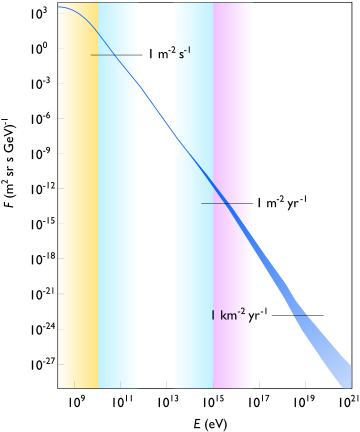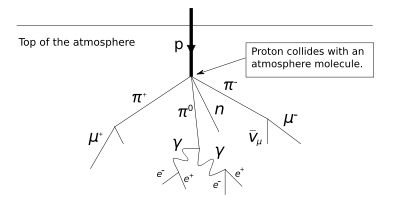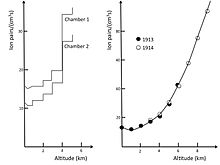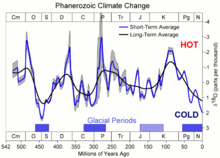- Cosmic ray
-
For the film, see Cosmic Ray (film)."Cosmic radiation" redirects here. For some background types of cosmic radiation, see cosmic background radiation and cosmic background.
Cosmic rays are energetic charged subatomic particles, originating from outer space. They may produce secondary particles that penetrate the Earth's atmosphere and surface.The term ray is historical as cosmic rays were thought to be electromagnetic radiation. Most primary cosmic rays (those that enter the atmosphere from deep space) are composed of familiar stable subatomic particles that normally occur on Earth, such as protons, atomic nuclei, or electrons. However, a very small fraction are stable particles of antimatter, such as positrons or antiprotons, and the precise nature of this remaining fraction is an area of active research.
About 89% of cosmic rays are simple protons or hydrogen nuclei, 10% are helium nuclei or alpha particles, and 1% are the nuclei of heavier elements. These nuclei constitute 99% of the cosmic rays. Solitary electrons (much like beta particles, although their ultimate source is unknown) constitute much of the remaining 1%.
The variety of particle energies reflects the wide variety of sources. The origins range from processes on the Sun (and presumably other stars as well), to as yet unknown physical mechanisms in the farthest reaches of the observable universe. There is evidence that very high energy cosmic rays are produced over far longer periods than the explosion of a single star or sudden galactic event, suggesting multiple accelerating processes that cover very long distances with regard to the size of stars. The obscure mechanism of cosmic ray production at galactic distances is partly a result of the fact that (unlike other radiations) magnetic fields in our galaxy and other galaxies bend cosmic ray direction severely, so that they arrive nearly randomly from all directions, hiding any clue of the direction of their initial sources. Cosmic rays can have energies of over 1020 eV, far higher than the 1012 to 1013 eV that Terrestrial particle accelerators can produce. There has been interest in investigating cosmic rays of even greater energies.[1]
Cosmic rays are enriched in lithium, beryllium, and boron with regard to the relative abundance of these elements in the universe compared to hydrogen and helium, and thus are thought to have a primary role in the synthesis of these three elements through the process of "cosmic ray nucleosynthesis". They also produce some so-called cosmogenic stable isotopes and radioisotopes on Earth, such as carbon-14.[2] In the history of particle physics, cosmic rays were the source of the discovery of the positron, muon, and pi meson. Cosmic rays compose a large part of natural background radiation on Earth. Since the intensity of cosmic rays is much larger outside the Earth's atmosphere and magnetic field, it is expected to have a major impact on the design of spacecraft that can safely transport humans in interplanetary space.
Contents
Composition
Cosmic rays may broadly be divided into two categories: primary and secondary. The cosmic rays that originate from astrophysical sources are primary cosmic rays; these primary cosmic rays interact with interstellar matter creating secondary cosmic rays. The Sun also emits low energy cosmic rays associated with solar flares. Almost 90% of cosmic rays are protons, about 9% are helium nuclei (alpha particles) and nearly 1% are electrons. The ratio of hydrogen to helium nuclei (28%) is about the same as the primordial elemental abundance ratio of these elements (24%).
The remaining fraction is made up of the other heavier nuclei that are nuclear synthesis end products, products of the Big Bang, primarily lithium, beryllium, and boron. These light nuclei appear in cosmic rays in much greater abundance (~1%) than in the solar atmosphere, where their abundance is about 10−9% that of helium.
This abundance difference is a result of the way secondary cosmic rays are formed. Carbon and oxygen nuclei collide with interstellar matter to form lithium, beryllium and boron in a process termed cosmic ray spallation. Spallation is also responsible for the abundances of scandium, titanium, vanadium, and manganese ions in cosmic rays produced by collisions of iron and nickel nuclei with interstellar matter. See Natural Environmental Radioactivity.
Satellite experiments have found evidence of a few antiprotons and positrons in primary cosmic rays, although there is no evidence of complex antimatter atomic nuclei, such as anti-helium nuclei (anti-alpha) particles. Antiprotons arrive at Earth with a characteristic energy maximum of 2 GeV, indicating their production in a fundamentally different process from cosmic ray protons.[3]
Flux
The flux of incoming cosmic rays at the upper atmosphere is dependent on the solar wind, the Earth's magnetic field, and the energy of the cosmic rays.
The solar wind decelerates the incoming particles and blocks some of the particles with energies below about 1 GeV. The amount of solar wind is not constant due to changes in solar activity. Thus, the level of the cosmic ray flux varies with solar activity. The Earth's magnetic field deflects some of the cosmic rays, giving rise to the observation that the flux is apparently dependent on latitude, longitude, and azimuth angle. The magnetic field lines deflect the cosmic rays towards the poles, giving rise to the aurora.
At distances of ~94 AU from the Sun, the solar wind undergoes a transition, called the termination shock, from supersonic to subsonic speeds. The region between the termination shock and the heliopause acts as a barrier to cosmic rays, decreasing the flux at lower energies by about 90%.
In the past, it was believed that the cosmic ray flux remained fairly constant over time. However, recent research suggests 1.5 to 2-fold millennium-timescale changes in the cosmic ray flux in the past forty thousand years.[4]
Detection

 The Moon as seen by the Compton Gamma Ray Observatory, in gamma rays of greater than 20 MeV. These are produced by cosmic ray bombardment of its surface.[5]
The Moon as seen by the Compton Gamma Ray Observatory, in gamma rays of greater than 20 MeV. These are produced by cosmic ray bombardment of its surface.[5]Cosmic rays collide with the nuclei of atmospheric gases, producing a shower of, among others, pions and kaons, that decay into muons. These muons are able to reach the surface of the Earth, and even penetrate for some distance into shallow mines. Muons are easily be detected by many types of particle detectors such as cloud chambers or bubble chambers or scintillation detectors. Several muons observed by separated detectors at the same instant indicates that they have been produced in the same shower event.
Cosmic rays impacting other planetary bodies in the Solar System are detected indirectly by observing high energy gamma ray emissions by gamma-ray telescope. These are distinguished from radioactive decay processes by their higher energies above about 10 MeV.
Detection by particle track-etch technique
Cosmic rays can also be detected directly by particle detectors aboard satellites or high altitude balloons. In a pioneering technique developed by Robert Fleischer, P. Buford Price, and Robert M. Walker,[6] sheets of clear plastic, like 1/4 mil Lexan polycarbonate, are stacked together and exposed directly to cosmic rays in space or high altitude. The nuclear charge causes chemical bond breaking or ionization in the plastic. At the top of the plastic stack, the ionization is less due to the high cosmic ray speed. As the cosmic ray speed decreases due to deceleration in the stack, the ionization increases along the path. The resulting plastic sheets are "etched" or slowly dissolved in warm caustic sodium hydroxide solution, that removes the surface material at a slow, known rate. The caustic sodium hydroxide dissolves at a faster rate along the path of the ionized plastic. The net result is a conical shaped pit or etch pit in the plastic. The etch pits are measured under a high power microscope (typically 1600X oil-immersion), and the etch rate is plotted as a function of the depth in the stacked plastic. This yields a unique curve for each atomic nucleus of Z from 1 to 92, allowing identification of both the charge and energy of the cosmic ray that traverses the plastic stack. The more extensive the ionization along the path; the higher the charge.
This technique has been used with great success for detecting not only cosmic rays, but fission product nuclei for neutron detectors.
Detection by air shower
When cosmic rays enter the Earth's atmosphere they collide with molecules, mainly oxygen and nitrogen, to produce a cascade of billions of lighter particles, a so-called air shower.
All of the produced particles stay within about one degree of the primary particle's path. Typical particles produced in such collisions are charged mesons e.g. positive and negative pions and kaons. These subsequently decay into muons that are easily detected by many types of particle detectors.
Research and experiments
See also: Cosmic-ray observatoryThere are a number of cosmic ray research initiatives. These include, but are not limited to:
- Ground Experiment
- Akeno Giant Air Shower Array
- CHICOS
- High Resolution Fly's Eye Cosmic Ray Detector
- MAGIC
- MARIACHI
- Pierre Auger Observatory
- Telescope Array Project
- Washington Large Area Time Coincidence Array
- CLOUD
- Spaceship Earth (detector)
- Milagro
- Real-time Neutron Monitor Database (NMDB)
- KASCADE
- GAMMA
- GRAPES-3
- HEGRA
- Chicago Air Shower Array (CASA)
- IceCube
- Satellite Experiment
- Balloon-borne Experiment
- BESS(Balloon-borne Experiment with Superconducting Spectrometer)
- ATIC (Advanced Thin Ionization Calorimeter)
- TRACER (cosmic ray detector)
- TIGER
- Cosmic Ray Energetics And Mass(CREAM)
- PERDaix
- HEAT (High Energy Antimatter Telescope)
History
After the discovery of radioactivity by Henri Becquerel in 1896, it was generally believed that atmospheric electricity, ionization of the air, was caused only by radiation from radioactive elements in the ground or the radioactive gases or isotopes of radon they produce. Measurements of ionization rates at increasing heights above the ground during the decade from 1900 to 1910 showed a decrease that could be explained as due to absorption of the ionizing radiation by the intervening air.
In 1909 Theodor Wulf developed an electrometer, a device to measure the rate of ion production inside a hermetically sealed container, and used it to show higher levels of radiation at the top of the Eiffel Tower than at its base. However, his paper published in Physikalische Zeitschrift was not widely accepted. In 1911 Domenico Pacini observed simultaneous variations of the rate of ionization over a lake, over the sea, and at a depth of 3 meters from the surface. Pacini concluded from the decrease of radioactivity underwater that a certain part of the ionization must be due to sources other than the radioactivity of the Earth.[7]
Then, in 1912, Victor Hess carried three enhanced-accuracy Wulf electrometers[8] to an altitude of 5300 meters in a free balloon flight. He found the ionization rate increased approximately fourfold over the rate at ground level.[8] Hess also ruled out the Sun as the radiation's source by making a balloon ascent during a near-total eclipse. With the moon blocking much of the Sun's visible radiation, Hess still measured rising radiation at rising altitudes.[8] He concluded "The results of my observation are best explained by the assumption that a radiation of very great penetrating power enters our atmosphere from above." In 1913–1914, Werner Kolhörster confirmed Victor Hess' earlier results by measuring the increased ionization rate at an altitude of 9 km.
Hess received the Nobel Prize in Physics in 1936 for his discovery.[9][10]
The term "cosmic rays" was coined by Robert Millikan who confirmed in 1925 they were extraterrestrial in origin, and not produced by atmospheric electricity. Millikan believed that cosmic rays were high-energy photons with some secondary electrons produced by Compton scattering of gamma rays. Compton himself held the (correct) belief that cosmic rays were primarily charged particles. During the decade from 1927 to 1937, a wide variety of experimental investigations demonstrated that the primary cosmic rays are mostly positively charged particles, and the secondary radiation observed at ground level is composed primarily of electrons, photons and muons. In 1948, observations with nuclear emulsions carried by balloons to near the top of the atmosphere by Gottlieb and Van Allen showed that the primary cosmic particles are mostly protons with some helium nuclei (alpha particles) and a small fraction heavier nuclei.
In 1934, Bruno Rossi reported an observation of near-simultaneous discharges of two Geiger counters widely separated horizontally during a test of equipment he was using in a measurement of the so-called east-west effect. In his report on the experiment, Rossi wrote "...it seems that once in a while the recording equipment is struck by very extensive showers of particles, which causes coincidences between the counters, even placed at large distances from one another." In 1937 Pierre Auger, unaware of Rossi's earlier report, detected the same phenomenon and investigated it in some detail. He concluded that extensive particle showers are generated by high-energy primary cosmic-ray particles that interact with air nuclei high in the atmosphere, initiating a cascade of secondary interactions that ultimately yield a shower of electrons, photons, and muons that reach ground level.
Attempts were made to measure the primary cosmic ray component at very high altitude. Soviet physicist Sergey Vernov was the first to use radiosondes to perform cosmic ray readings. On April 1, 1935, he took measurements at heights up to 13.6 kilometers using a pair of Geiger counters in an anti-coincidence circuit to avoid counting secondary ray showers.[11][12]
Homi J. Bhabha derived an expression for the probability of scattering positrons by electrons, a process now known as Bhabha scattering. His classic paper, jointly with Walter Heitler, published in 1937 described how primary cosmic rays from space interact with the upper atmosphere to produce particles observed at the ground level. Bhabha and Heitler explained the cosmic ray shower formation by the cascade production of gamma rays and positive and negative electron pairs.
Measurements of the energy and arrival directions of the ultra-high energy primary cosmic rays by the techniques of "density sampling" and "fast timing" of extensive air showers were first carried out in 1954 by members of the Rossi Cosmic Ray Group at the Massachusetts Institute of Technology. The experiment employed eleven scintillation detectors arranged within a circle 460 meters in diameter on the grounds of the Agassiz Station of the Harvard College Observatory. From that work, and from many other experiments carried out all over the world, the energy spectrum of the primary cosmic rays is now known to extend beyond 1020 eV. A huge air shower experiment called the Auger Project is currently operated at a site on the pampas of Argentina by an international consortium of physicists, led by James Cronin, 1980 Nobel Prize in Physics of the University of Chicago and Alan Watson of the University of Leeds. Their aim is to explore the properties and arrival directions of the very highest energy primary cosmic rays. The results are expected to have important implications for particle physics and cosmology, due to a theoretical Greisen–Zatsepin–Kuzmin limit to the energies of cosmic rays from long distances (about 160 million light years) which occurs above 1020 eV.
In November, 2007 preliminary results were announced showing direction of origination of the 27 highest energy events were strongly correlated with the locations of active galactic nuclei [AGN], where bare protons are believed accelerated by strong magnetic fields associated with the large black holes at the AGN centers to energies of 1020 eV and higher.
Effects
Changes in atmospheric chemistry
Cosmic rays ionize the nitrogen and oxygen molecules in the atmosphere, which leads to a number of chemical reactions. One of the reactions results in ozone depletion. The magnitude of damage, however, is very small compared to the depletion caused by CFCs.[citation needed] Cosmic rays are also responsible for the continuous production of a number of unstable isotopes in the Earth’s atmosphere, such as carbon-14, via the reaction:

Cosmic rays kept the level of carbon-14 [2] in the atmosphere roughly constant (70 tons) for at least the past 100,000 years, until the beginning of above-ground nuclear weapons testing in the early 1950s. This is an important fact used in radiocarbon dating used in archaeology.
- Reaction products of primary cosmic rays, lifetime and reaction[13]
- Tritium (12.3 a): 14N(n, 3H)12C (Spallation)
- Beryllium-7 (53.3 d)
- Beryllium-10 (1.6E6 a): 14N(n,p α)10Be (Spallation)
- Carbon-14 (5730 a): 14N(n, p)14C (Neutron activation)
- Sodium-22 (2.6 a)
- Sodium-24 (15 h)
- Magnesium-28 (20.9 h)
- Silicon-31 (2.6 h)
- Silicon-32 (101 a)
- Phosphorus-32 (14.3 d)
- Sulfur-35 (87.5 d)
- Sulfur-38 (2.8 h)
- Chlorine-34 m (32 min)
- Chlorine-36 (3E5 a)
- Chlorine-38 (37.2 min)
- Chlorine-39 (56 min)
- Argon-39 (269 a)
- Krypton-85 (10.7 a)
Role in ambient radiation
Cosmic rays constitute a fraction of the annual radiation exposure of human beings on the Earth. For example, the average annual radiation exposure in Australia is 0.3 mSv due to cosmic rays, out of a total of 2.3 mSv.[14]
Effect on electronics
Cosmic rays have sufficient energy to alter the states of elements in electronic integrated circuits, causing transient errors to occur, such as corrupted data in electronic memory devices, or incorrect performance of CPUs, often referred to as "soft errors" (not to be confused with software errors caused by programming mistakes/bugs). This has been a problem in extremely high-altitude electronics, such as in satellites, but with transistors becoming smaller and smaller, this is becoming an increasing concern in ground-level electronics as well.[15] Studies by IBM in the 1990s suggest that computers typically experience about one cosmic-ray-induced error per 256 megabytes of RAM per month.[16]
To alleviate this problem, the Intel Corporation has proposed a cosmic ray detector that could be integrated into future high-density microprocessors, allowing the processor to repeat the last command following a cosmic-ray event.[17]
Cosmic rays are suspected as a possible cause of an in-flight incident in 2008 where an Airbus A330 airliner of Qantas twice plunged hundreds of feet after an unexplained malfunction in its flight control system. Many passengers and crew members were injured, some seriously. After this incident, the accident investigators determined that the airliner's flight control system had received a data spike that could not be explained, and that all systems were in perfect working order. This has prompted a software upgrade to all A330 and A340 airliners, worldwide, so that any data spikes in this system are filtered out electronically.[18]
Significance to space travel
Main article: Health threat from cosmic raysGalactic cosmic rays are one of the most important barriers standing in the way of plans for interplanetary travel by crewed spacecraft. Cosmic Rays also place a threat to electronics placed aboard outgoing probes. In 2010, a malfunction aboard the Voyager 2 space probe was credited to a single flipped bit, probably caused by a cosmic ray.
Role in lightning
Cosmic rays have been implicated in the triggering of electrical breakdown in lightning. It has been proposed that essentially all lightning is triggered through a relativistic process, "runaway breakdown", seeded by cosmic ray secondaries. Subsequent development of the lightning discharge then occurs through "conventional breakdown" mechanisms.[19]
Role in climate change
A role of cosmic rays directly or via solar-induced modulations in climate change was suggested by E.P.Ney in 1959 and by Robert Dickinson in 1975. In recent years, the idea has been revived most notably by Henrik Svensmark; the most recent IPCC study disputed the mechanism,[20] while the most comprehensive review of the topic to date states: "evidence for the cosmic ray forcing is increasing as is the understanding of its physical principles."[21]
Suggested mechanisms
Henrik Svensmark et al. have argued that solar variations modulate the cosmic ray signal seen at the Earth and that this would affect cloud formation and hence climate. Cosmic rays have been experimentally determined capable of producing ultra-small aerosol particles,[22] orders of magnitude smaller than cloud condensation nuclei (CCN).
According to a report about an ongoing CERN CLOUD research project[23] to detect any Cosmic ray forcing is challenging since on wide spread time scales changes in the Sun’s magnetic activity, Earth’s magnetic field, and the galactic environment must be taken into account. Empirically, increased galactic cosmic ray (GCR) flux seem to be associated with a cooler climate, a southerly shift of the ITCZ (Inter Tropical Convergence Zone)[citation needed] and a weakening of monsoon rainfalls and vice versa.[23] Claims have been made of identification of GCR climate signals in atmospheric parameters such as high latitude precipitation (Todd & Kniveton), and Svensmark's annual cloud cover variations, which were said to be correlated to GCR variation. Various proposals have been made for the mechanism by which cosmic rays might affect clouds, including ion mediated nucleation, and indirect effects on current flow density in the global electric circuit (see Tinsley 2000, and F. Yu 1999).... Other studies refer to the formation of relatively highly charged aerosols and cloud droplets at cloud boundaries, with an indirect effect on ice particle formation and altering aerosol interaction with cloud droplets.[23] Kirkby (2009) reviews developments and describes further cloud nucleation mechanisms that appear energetically favorable and depend on GCRs.,[24][25]
Geochemical and astrophysical evidence
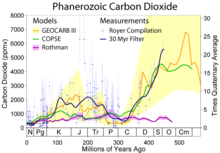 Carbon dioxide concentrations on 500 million year scale[26]
Carbon dioxide concentrations on 500 million year scale[26]
Nir Shaviv has argued that climate signals on geological time scales are attributable to changing positions of the galactic spiral arms of the Milky Way Galaxy, and that cosmic ray flux variability is the dominant "climate driver" over these time periods.[27] Nir Shaviv and Jan Veizer in 2003[28] argue, that in contrast to a carbon based scenario, the model and proxy based estimates of atmospheric CO2 levels especially for the early Phanerozoic (see diagrams) do not show correlation with the paleoclimate picture that emerged from geological criteria, while cosmic ray flux would do.
The 2007 IPCC reports, however, strongly attribute a major role of anthropogenic carbon dioxide in the ongoing global warming, but as "different climate changes in the past had different causes" a driving role of carbon dioxide in the geological past is neither focus of the IPCC nor purported. Similarly, according a BBC report a 2008 Lancaster University study produced "further compelling evidence showing that modern-day climate change is not caused by changes in the Sun's activity".[29]
A comprehensive study of different research institutes was published 2007 by Scherer et al. in Space Science Reviews 2007.[30] The study combines geochemical evidence both on temperature, cosmic rays influence and as well astrophysical deliberations suggesting a major role in climate variability over different geological time scales. Proxy data of CRF influence comprise among others isotopic evidence in sediments on the Earth and as well changes in (iron) meteorites.
See also
- Environmental radioactivity
- Cosmic ray spallation
- Forbush decrease
- Gilbert Jerome Perlow
- Ultra-high-energy cosmic ray
- Galactic cosmic ray
- Extragalactic cosmic ray
- Solar energetic particle
- Track Imaging Cherenkov Experiment
Notes
- ^ L. Anchordoqui, T. Paul, S. Reucroft, J. Swain (2003). "Ultrahigh Energy Cosmic Rays: The state of the art before the Auger Observatory". International Journal of Modern Physics A 18 (13): 2229. arXiv:hep-ph/0206072. Bibcode 2003IJMPA..18.2229A. doi:10.1142/S0217751X03013879.
- ^ a b Trumbore, Susan (2000). Noller, J. S., J. M. Sowers, and W. R. Lettis. ed. Quaternary Geochronology: Methods and Applications. Washington, D.C.: American Geophysical Union. pp. 41–59. ISBN 0-87590-950-7. http://www.agu.org/books/rf/v004/.
- ^ Secondary antiprotons and propagation of cosmic rays in the Galaxy and heliosphere. I. V. Moskalenko (NASA/GSFC), A. W. Strong (MPE, Garching), J. F. Ormes (NASA/GSFC), M. S. Potgieter (Potchefstroom U.) Astrophys.J.565:280-296,2002 cite:arXiv:astro-ph/0106567v2 [1]
- ^ D. Lal, A.J.T. Jull, D. Pollard, L. Vacher (2005). "Evidence for large century time-scale changes in solar activity in the past 32 Kyr, based on in-situ cosmogenic 14C in ice at Summit, Greenland". Earth and Planetary Science Letters 234 (3–4): 335–249. Bibcode 2005E&PSL.234..335L. doi:10.1016/j.epsl.2005.02.011.
- ^ "EGRET Detection of Gamma Rays from the Moon". NASA/GSFC. 1 August 2005. http://heasarc.gsfc.nasa.gov/docs/cgro/epo/news/gammoon.html. Retrieved 2010-02-11.
- ^ R.L. Fleischer, P.B. Price, R.M. Walker (1975). Nuclear tracks in solids: Principles and applications. University of California Press.
- ^ D. Pacini (1912). "La radiazione penetrante alla superficie ed in seno alle acque". Il Nuovo Cimento, Series VI 3: 93–100. doi:10.1007/BF02957440.
- Translated and commented in A. de Angelis (2010). "Penetrating Radiation at the Surface of and in Water". arXiv:1002.1810 [physics.hist-ph].
- ^ a b c Nobel Prize in Physics 1936 – Presentation Speech
- ^ V.F. Hess (1936). "The Nobel Prize in Physics 1936". The Nobel Foundation. http://nobelprize.org/nobel_prizes/physics/laureates/1936/index.html. Retrieved 2010-02-11.
- ^ V.F. Hess (1936). "Unsolved Problems in Physics: Tasks for the Immediate Future in Cosmic Ray Studies". Nobel Lectures. The Nobel Foundation. http://nobelprize.org/nobel_prizes/physics/laureates/1936/index.html. Retrieved 2010-02-11.
- ^ J.L. DuBois, R.P. Multhauf, C.A. Ziegler (2002). The Invention and Development of the Radiosonde. Smithsonian Studies in History and Technology. 53. Smithsonian Institution Press. http://www.sil.si.edu/smithsoniancontributions/HistoryTechnology/pdf_lo/SSHT-0053.pdf.
- ^ S. Vernoff (1935). "Radio-Transmission of Cosmic Ray Data from the Stratosphere". Nature 135 (3426): 1072. Bibcode 1935Natur.135.1072V. doi:10.1038/1351072c0.
- ^ "Natürliche, durch kosmische Strahlung laufend erzeugte Radionuklide". http://www.um.baden-wuerttemberg.de/servlet/is/34839/Natuerliche_durch_kosmische_Strahlung_laufend_erzeugte_Radionuklide.pdf?command=downloadContent&filename=Natuerliche_durch_kosmische_Strahlung_laufend_erzeugte_Radionuklide.pdf. Retrieved 2010-02-11. (German)
- ^ http://www.arpansa.gov.au/pubs/baseline/bg_rad.pdf DEAD LINK
- ^ IBM experiments in soft fails in computer electronics (1978-1994), from Terrestrial cosmic rays and soft errors, IBM Journal of Research and Development, Vol. 40, No. 1, 1996. Retrieved April 16, 2008.
- ^ Scientific American (2008-07-21). "Solar Storms: Fast Facts". Nature Publishing Group. http://www.scientificamerican.com/article.cfm?id=solar-storms-fast-facts. Retrieved 2009-12-08.
- ^ Intel plans to tackle cosmic ray threat, BBC News Online, 8 April 2008. Retrieved April 16, 2008.
- ^ Cosmic rays may have hit Qantas plane off the coast of North West Australia, News.com.au, 18 November 2009. Retrieved 19 November 2009.
- ^ Runaway Breakdown and the Mysteries of Lightning, Physics Today, May 2005.
- ^ Changes in Atmospheric Constituents and in Radiative Forcing IPCC Fourth Assessment Report Working Group I Report "The Physical Science Basis" 2007 [2]
- ^ K. Scherer, H. Fichtner et al. (December, 2006). "Interstellar-Terrestrial Relations: Variable Cosmic Environments, The Dynamic Heliosphere, and Their Imprints on Terrestrial Archives and Climate". Space Science Reviews (Springer Netherlands) 127 (1–4): 327–465. Bibcode 2006SSRv..127..327S. doi:10.1007/s11214-006-9126-6. ISSN 0038-6308.
- ^ Henrik Svensmark, Jens Olaf Pepke Pedersen, Nigel Marsh, Martin Enghoff and Ulrik Uggerhøj, "Experimental Evidence for the role of Ions in Particle Nucleation under Atmospheric Conditions", Proceedings of the Royal Society A, (Early Online Publishing), 2006.
- ^ a b c Kirkby, J. 2008. Cosmic rays and climate. Surveys in Geophysics 28: 333-375)
- ^ Cosmic Rays and Climate Video Jasper Kirkby, CERN Colloquium, 4 June 2009
- ^ Cosmic Rays and Climate Presentation Jasper Kirkby, CERN Colloquium, 4 June 2009
- ^ Similar displays in Veizer and Shaviv 2003 and in 2001 IPCC Mitchell report
- ^ [3], [4]sciencebits.com/CO2orSolar Science bit display of Nir Shaviv papers
- ^ N.J. Shaviv, J. Veizer (2003). "Celestial driver of Phanerozoic climate?". GSA Today 7 (7): 4–10. Bibcode 2003EAEJA....13401S. ftp://rock.geosociety.org/pub/GSAToday/gt0307.pdf.
- ^ R. Black (3 April 2008). "'No Sun link' to climate change". BBC News. http://news.bbc.co.uk/1/hi/sci/tech/7327393.stm. Retrieved 2010-02-11.
- ^ K. Scherer et al. (2006). "Interstellar-Terrestrial Relations: Variable Cosmic Environments, The Dynamic Heliosphere, and Their Imprints on Terrestrial Archives and Climate". Space Science Reviews 127 (1–4): 327. Bibcode 2006SSRv..127..327S. doi:10.1007/s11214-006-9126-6.
References
- R.G. Harrison and D.B. Stephenson, Detection of a galactic cosmic ray influence on clouds, Geophysical Research Abstracts, Vol. 8, 07661, 2006 SRef-ID: 1607-7962/gra/EGU06-A-07661
- C. D. Anderson and S. H. Neddermeyer, Cloud Chamber Observations of Cosmic Rays at 4300 Meters Elevation and Near Sea-Level, Phys. Rev 50, 263,(1936).
- M. Boezio et al., Measurement of the flux of atmospheric muons with the CAPRICE94 apparatus, Phys. Rev. D 62, 032007, (2000).
- R. Clay and B. Dawson, Cosmic Bullets, Allen & Unwin, 1997. ISBN 1-86448-204-4
- T. K. Gaisser, Cosmic Rays and Particle Physics, Cambridge University Press, 1990. ISBN 0-521-32667-2
- P. K. F. Grieder, Cosmic Rays at Earth: Researcher’s Reference Manual and Data Book, Elsevier, 2001. ISBN 0-444-50710-8
- A. M. Hillas, Cosmic Rays, Pergamon Press, Oxford, 1972 ISBN 0-08-016724-1
- J. Kremer et al., Measurement of Ground-Level Muons at Two Geomagnetic Locations, Phys. Rev. Lett. 83, 4241, (1999).
- S. H. Neddermeyer and C. D. Anderson, Note on the Nature of Cosmic-Ray Particles, Phys. Rev. 51, 844, (1937).
- M. D. Ngobeni and M. S. Potgieter, Cosmic ray anisotropies in the outer heliosphere, Advances in Space Research, 2007.
- M. D. Ngobeni, Aspects of the modulation of cosmic rays in the outer heliosphere, M.Sc Dissertation, Northwest University (Potchefstroom campus) South Africa 2006.
- D. Perkins, Particle Astrophysics, Oxford University Press, 2003. ISBN 0-19-850951-0
- C. E. Rolfs and S. R. William, Cauldrons in the Cosmos, The University of Chicago Press, 1988. ISBN 0-226-72456-5
- B. B. Rossi, Cosmic Rays, McGraw-Hill, New York, 1964.
- Martin Walt, Introduction to Geomagnetically Trapped Radiation, 1994. ISBN 0-521-43143-3
- M. Taylor and M. Molla, Towards a unified source-propagation model of cosmic rays, Pub. Astron. Soc. Pac. 424, 98 (2010).
- J. F. Ziegler, The Background In Detectors Caused By Sea Level Cosmic Rays, Nuclear Instruments and Methods 191, 419, (1981).
- TRACER Long Duration Balloon Project: the largest cosmic ray detector launched on balloons.
- HiRes Fly's Eye
- Carlson, Per; De Angelis, Alessandro (2011). "Nationalism and internationalism in science: the case of the discovery of cosmic rays". European Physical Journal H. Bibcode 2010EPJH...35..309C. doi:10.1140/epjh/e2011-10033-6.
External links
- Aspera European network portal
- Animation about cosmic rays on astroparticle.org
- Particle Data Group review of Cosmic Rays by C. Amsler et al., Physics Letters B667, 1 (2008).
- Introduction to Cosmic Ray Showers by Konrad Bernlöhr.
- NOAA FTP: Lal, D., et al., 2005. Data on cosmic ray flux derived from C14 concentrations in the GISP2 Greenland ice core.
- BBC news, Cosmic rays find uranium, 2003.
- BBC news, Rays to nab nuclear smugglers, 2005.
- BBC news, Physicists probe ancient pyramid (using cosmic rays), 2004.
- Shielding Space Travelers by Eugene Parker.
- Anomalous cosmic ray hydrogen spectra from Voyager 1 and 2
- Anomalous Cosmic Rays (From NASA's Cosmicopia)
- Review of Cosmic Rays
- Composition of Solar cosmic rays
- "Who's Afraid of a Solar Flare? Solar activity can be surprisingly good for astronauts." October 7, 2005, at Science@NASA]
- History of Cosmic Rays
- Amateur Muon Detector – schematics and articles
Radiation (Physics & Health) Main articles Background radiation · Cosmic ray · Gamma ray · Nuclear fission · Nuclear fusion · Nuclear radiation (Nuclear reactors · Nuclear weapons) · Particle accelerators · Radioactive materials (Radioactive decay) · X-rayElectromagnetic radiation
and healthRadiation therapy · Radiation poisoning · Radioactivity in the life sciences · List of civilian radiation accidents
Health physics · Laser safety · Lasers and aviation safety · Mobile phone radiation and health · Wireless electronic devices and healthRelated articles See also categories: Radiation effects, Radioactivity, and Radiobiology.Categories:- Cosmic rays
- Astroparticle physics
- Radiation
- Stellar phenomena
- Solar phenomena
- Ground Experiment
Wikimedia Foundation. 2010.

